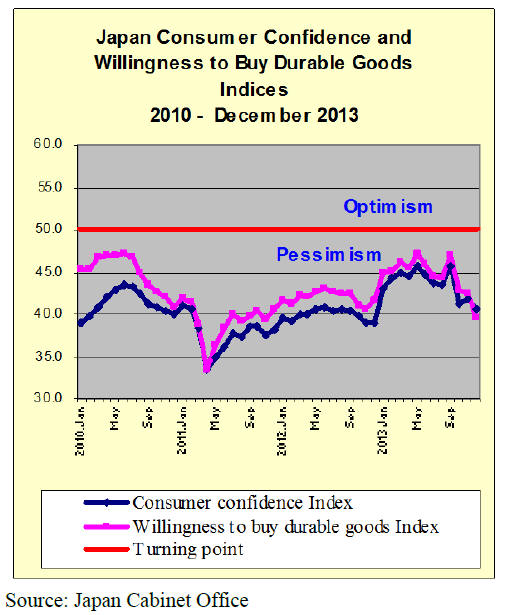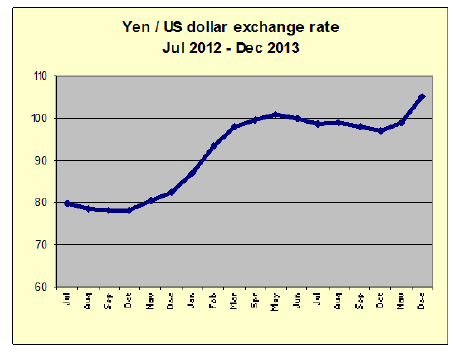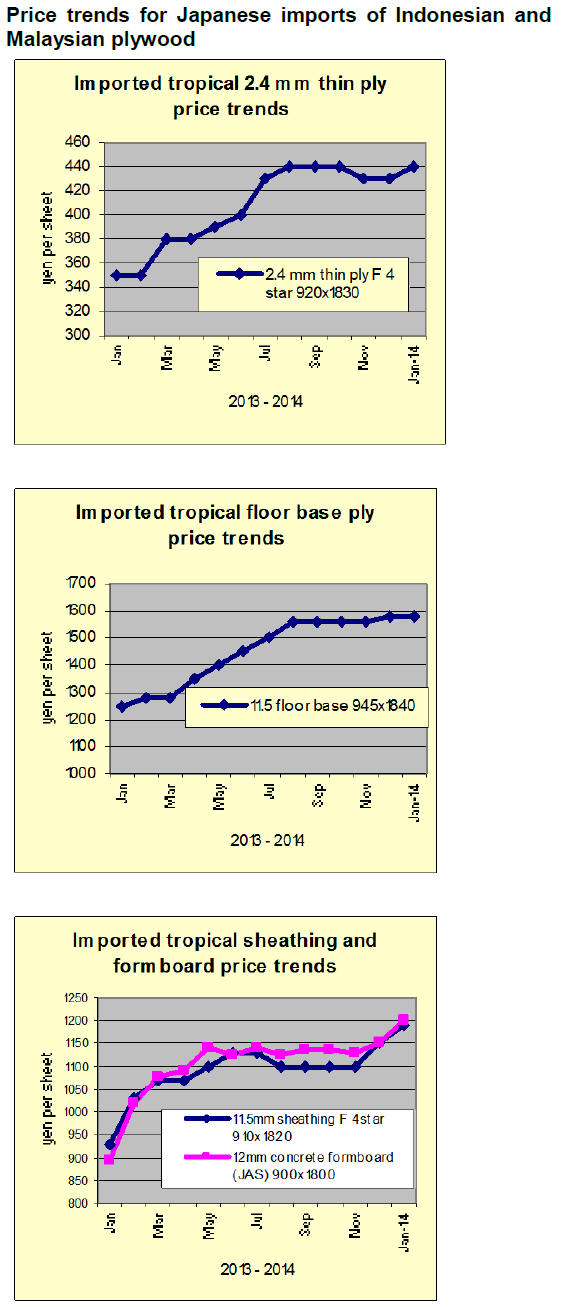Japan Wood Products
Prices
Dollar Exchange Rates of
27th January 2014
Japan Yen 102.55
Reports From Japan
Fiscal stimulus to offset tax hike says IMF
The Japanese government recently released revised GDP
figures for the third quarter of 2013 showing the economy
expanded by only 1.1% , slower than the forecast annual
1.9%.
A new International Monetary Fund (IMF) report forecasts
growth in the global economy driven especially by
expansion in the US and UK economies.
See IMF World Economic Outlook at:
http://www.imf.org/external/pubs/ft/weo/2014/update/01/p
df/infographic.pdf
On Japan, the IMF report says continued fiscal stimulus,
which lifted growth in 2013, could offset the negative
effects of the consumption tax increase to 8 percent from
the current 5 percent in April. Because of this the IMF
thinks 2014 growth could be in the region of 1.7%.
For 2015 the IMF forecasts Japanese GDP growth will
slow to 1% while global growth could be as much as 3.9%
and growth in advanced economies could be around 2.3%.
December consumer confidence falls
Japan's Cabinet Office has released the results of the
December consumer confidence survey and reports an
unexpected decline in December.

The consumer sentiment index fell to 40.6 from 41.9 in
November. Analysts put the weakening of consumer
sentiment down to attitudes towards the coming increase
in consumption tax.
The index for general households, which includes views
on incomes and jobs, was negative in December and the
index for consumer willingness to purchase durable goods
also fell sharply. An index reading below 50 suggests
consumer pessimism.
Massive trade deficit reported for 2013
Japan's Ministry of Finance has released data showing the
trade deficit in 2013 stood at a massive yen 11.47 trillion
yen (around US$112 billion). The main reasons cited to
explain the size of the deficit were the ballooning energy
import bill and the weak yen.
Japan has shut down all nuclear power plants and is
relying on imported oil and gas to produce its electricity
needs.
Of the overall deficit most (yen 13 trillion) was with
Middle East countries, the source of the largest share of
Japan's imports of oil and gas.
For details see:
http://www.customs.go.jp/toukei/shinbun/tradest_
e/2013/2013_114e.pdf
Yen strengthens against the US dollar
The yen strengthened in the second half of the month to a
high of 102 to the US dollar after data from China showed
that fourth quarter growth was below expectation which
caused money to flow into yen.
However, analysts expect the yen to weaken progressively
throughout out 2014 as the US economy picks up further
and as Japan‟s Central Bank remains firm on its monetary
easing policy.

Workforce reform
The Japanese government is making it easier for the
private sector to recruit foreign workers for highly-skilled
positions and as trainees, a move say analysts, which will
help offset a declining domestic workforce and could
speed economic growth.
This move comes on the heels of a decision to encourage
and support expansion of the female workforce. To
encourage qualified and skilled mothers to return to work
the government is strengthening the child care system and
is setting voluntary targets for female worker employment
by companies.
The domestic workforce in Japan is shrinking as the
country has the most rapidly aging society in the world,
with a quarter of the population already over 65. The
expansion of the foreign workforce and getting more
women employed or re-employed are important for easing
labour shortages and increasing tax revenues.
The government has indicated it is considering lowering
corporate taxes to make Japanese firms more competitive.
Japan's corporate tax rate, (close to 40 percent for a Tokyo
corporation) is among the highest in the world.
Trade news from the Japan Lumber Reports (JLR)
The Japan Lumber Reports (JLR), a subscription trade
journal published every two weeks in English, is
generously allowing the ITTO Tropical Timber Market
Report to extract and reproduce news on the Japanese
market.
For the JLR report please see:
http://www.n-mokuzai.com/modules/general/index.php?id=7
Wood Use Point system
The Forestry Agency announced Douglas fir produced in
the U.S.A. is additional species for the Wood Use Point
system and also added as type of construction wood
prefabricated building in Hokkaido which is built with
local larch and fir as main structural materials. American
Softwood Conference also announced that Douglas fir is
additionally authorized for the system.
This is the first foreign species authorized for the system.
The two conditions of authorized species for the system
are the resources are increasing and it contributes
activating and vitalizing local economy.
Orvis to close Himeji mill
Orvis Corporation (Fukuyama, Hiroshima prefecture), the
largest radiate pine lumber manufacturer in Japan,
announced it would close down Himeji sawmill for good
at the end of April because of prolonging depression of
crating lumber demand.
The mill was built in 2008 as the most modern large
sawmill to produce lumber for crating, wooden drum and
temporary materials for public works.
At the peak time of August 2012, it consumed 25,000
cubic meters of radiate pine logs a month then since late
2012, it started reducing the production because of slower
demand and monthly log consumption had been about
17,500 cbms a month in 2013, which was 30% less than
2012.
Long lasting strong yen rate of about 80 yen per dollar
discouraged export businesses in Japan so that crating
demand for export cargoes stagnated for a long time then
the cost of logs increased by higher export prices from New
Zealand pushed by aggressive Chinese purchase then
devaluation of the yen over 100 yen per dollar since late
last year pushed the arrived log cost higher.
South Sea (tropical) logs
Log producing regions in the South East Asia are in rainy
season now and log production is dropping sharply.
In Sarawak, Malaysia, heavy rain hit the area and flooded
cities. Also New Year holidays took logging camp
workers out so early January log production dropped
considerably and some local plywood mills are having
hard time to keep running without log supply. Japanese
log importers have trouble to fill up log ships. Some
importers send ships to Sabah to fill up ships, which costs
more by deviation penalty.
Even in this tight supply situation, there is no panic and
price surge seen in last year because India has been
holding down its purchase because of devaluation of their
currency, Rupee so they do not pay higher prices for logs
to fill up ships.
Export log prices in Sarawak have been gradually firming
but there is no drastic price increase. Meranti regular FOB
is unchanged at $285 per cbm and meranti small are $245
and super small are $225. Meranti low grade regular for
India is about $250, $10 higher than December.
In Sabah, FOB of seraya regular is $265 and kapur regular
is $375.
In PNG, China continues buying actively. China buys all
type of logs compared to Japan and Korea, which are fussy
about grade, diameter and specifications so log suppliers
prefer to sell to China.
Plywood markets
Softwood plywood market continues busy and brisk but
distribution is getting difficult due to shortage of trucks.
Deliveries to direct users like house builders and
precutting plants had been smooth but now some
precutting plants suffer delayed delivery.
There are many house orders, which have to complete
works by the end of March. Supply of building materials is
tight due to busy construction works then came delayed
delivery of plywood.

Softwood plywood shipment from the mills continues
record high level for October through December.
November shipment was 246,000 cbms, all time high
figure and this is 8.8% more than November last year.
Meantime the production in November was 229,300 cbms,
6.6% more than the same month a year ago. This is the
third largest monthly production next to July last year. In
November, the production was less than the shipment so
that the inventories drooped down to 121,800 cbms, 10.9%
less than October.
|